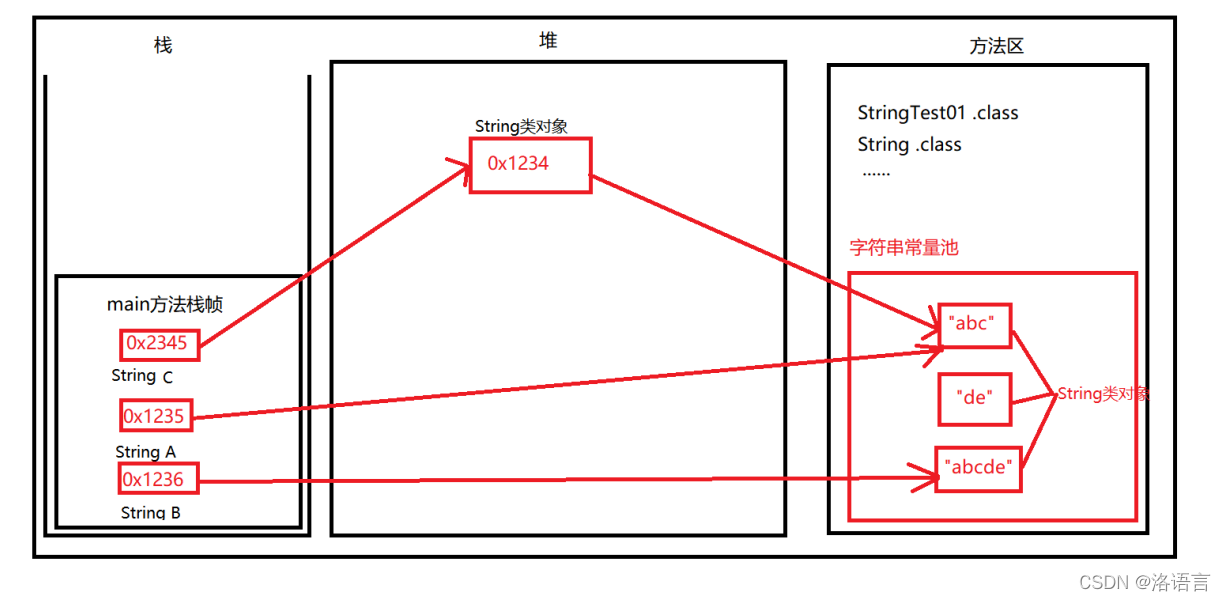String类基本概念
- String类属于引用数据类型,不属于基本数据类型。
- 在Java中只要是" "(双引号)中的,都是String对象。
- java中规定,双引号中的字符串是不可变的,也就是说"abc"自出生到死亡都不可能变成"abcd",也不能变成"ab"。
- 在JDK中双引号括起来的字符串都是存储在方法区的字符串常量池当中的。(因为在实际开发中,字符串的使用频率十分高,为了执行效率,就把字符串放在了方法区中的字符串常量池当中)
String字符串的存储原理
- 通过 String s = “abc” 这种方式,会在方法区中的字符串常量池创建对象,s会保存该字符串在字符串常量池中的地址。
- 通过 String s = new String(“abc”)的方式创建对象,首先会在字符串常量池中创建"abc"对象(如果字符串常量池中已经有了"abc"则不会再次创建),然后会在堆区创建String类对象,它会储存" abc "在方法区中的地址,s又会保存堆中String对象的地址。
看以下代码:
public class StringTest01 {
//这两行代码表示创建3个字符串对象,且都在字符串常量池中
String A = "abc";
String B = "abc" + "de";
//通过 new 来创建字符串对象,会先在字符串常量池中寻找"abc"
//找不到的话就会在字符串常量池中创建一个"abc"对象
//在堆中创建创建字符串对象,并且保存"abc"在字符串常量池中的地址
String C = new String("abc");
}
按照以上代码画出JVM内存简图如下:

知道了String类字符串的存储原理之后,就可以很容易知道以下代码的编译结果:
public class StringTest01 {
public static void main(String[] args) {
//没有在堆中创建对象
//s1与s2都存的是"hello"在字符串常量池中的地址
String s1 = "hello";
String s2 = "hello";
//在堆中创建了对象
//m,n分别存的是他们在堆中对象的地址
String m = new String("你好!");
String n = new String("你好!");
System.out.println(s1 == s2);//结果为true
System.out.println(m == n);//结果为false
}
}
String类的常用构造方法
//String类构造方法的使用
public class StringTest02 {
public static void main(String[] args) {
byte []x1 = { 97 , 98 , 99 };
char []x2 = {'我','是','中','国','人'};
//String s = new String(byte数组);
String y1 = new String(x1);
System.out.println(y1);//ABC
//String s = new String(byte数组,偏移量,长度)
String y2 = new String(x1,1,2);
System.out.println(y2);//BC
//String s = new String(char数组)
String y3 = new String(x2);
System.out.println(y3);//我是中国人
//String s = new String(char数组,偏移量,长度)
String y4 = new String(x2,2,3);
System.out.println(y4);//中国人
}
}
String类中常用方法
public class StringTest03 {
public static void main(String[] args) {
//public char charAt(int index)方法
//返回索引值处的char类型字符
char s1 = "中国人".charAt(1);
System.out.println(s1);//国
//public int compareTo(String anotherString)方法
//按字典序比较两个字符串
System.out.println("abc".compareTo("abd"));//负整数
System.out.println("abc".compareTo("abc"));//0
System.out.println("abc".compareTo("abb"));//正整数
//public boolean contains(CharSequence s)方法
//判断字符串是否包含s
System.out.println("abcdefg".contains("efg"));//true
System.out.println("abcdefg".contains("hij"));//false
//public boolean endsWith(String suffix)方法
//判断字符串是否以suffix结尾
System.out.println("abcde".endsWith("cde"));//true
System.out.println("abcde".endsWith("qwe"));//false
//public boolean equalsIgnoreCase(String anotherString) 方法
//判断两个字符串是否相等,忽略大小写
System.out.println("ABcd".equalsIgnoreCase("abCD"));//true
//public byte[] getBytes()
//将字符串转换成byte数组,并返回
byte [] s2 = "abcdefg".getBytes();
for (int i = 0; i < s2.length; i++) {
System.out.print(s2[i] + " ");
}//97 98 99 100 101 102 103
//public int indexOf(String str)
//判断某个子字符串在当前字符串中第一次出现处的索引
//若子字符串不存在,返回-1
System.out.println("abcdefghigk".indexOf("hig"));//7
System.out.println("abc".indexOf("fgh"));//-1
//public int lastIndexOf(String str)
//判断某个子字符串最后一次出现在当前字符串中的索引
System.out.println("abcdhdhdabc".lastIndexOf("abc"));//8
//public boolean isEmpty()
//判断字符串是否为空串
//底层调用length()方法,空串长度为0
//注意:判断数组长度是length属性,判断字符串长度是length()方法
System.out.println("".isEmpty());//true
//public String replace(char oldChar,char newChar)
//返回一个将原字符串中所有的oldChar替换为newChar的新字符串,不改变原字符串
String s3 = "aaatttooo";
System.out.println( s3.replace('t','q'));//aaaqqqooo
//public String replace(CharSequence target,CharSequence replacement)
//CharSequence可以看出String
//将原字符串中的 target 全部换成 replacement
String s4 = "abcsgdjsssjabcjdjjdjabc";
System.out.println(s4.replace("abc","www"));//wwwsgdjsssjwwwjdjjdjwww
//public String[] split(String regex)
//以regex为分界线,将字符串分割保存在一个字符串数组当中,并返回
String s5 = "2022-3-19";
String [] str = s5.split("-");
System.out.println(str[0] + str[1] + str[2]);//2022319
//public String substring(int beginIndex)
//返回一个以索引beginIndex开始直至结尾的字符串
System.out.println("abcdefgh".substring(4));//efgh
//public String substring(int beginIndex,int endIndex)
//返回一个以索引值beginIndex开始,以索引值endIndex结束(不包含该索引值处的字符)的子字符串
System.out.println("abcdefgh".substring(2,5));//cde
//public char[] toCharArray()
//将一个字符串以字符数组的形式返回
char[] str2 = "abcdefg".toCharArray();
for(int i = 0 ; i < str2.length ; i++){
System.out.println(str2[i]);
}
//public String toLowerCase()
//返回一个将原字符串中所有字符变成小写的新字符串
System.out.println("ABcDeFG".toLowerCase());//abcdefg
//public String toUpperCase()
//返回一个将原字符串中所有字符变成大写的新字符串
System.out.println("aCbcdEfg".toUpperCase());//ABCDEFG
//public String trim()
// 返回一个去除字符串的前后空白(空格)的新字符串
System.out.println(" abcdefg ".trim());//abcdefg
//public static String valueOf(参数列表)
//参数列表可以是int型,char型,int数组,对象 等等.......
//String类中唯一一个静态方法,可以直接调用
//将非字符串转换为字符串
//println()底层调用的就是valueOf()方法,只要是打印在控制台上的都是字符串
System.out.println(String.valueOf(true));
}
}
StringBuffer类
思考:
- 频繁使用字符串拼接会有什么影响?
- java中字符串是不可变的,每拼接一次都会产生一个新的字符串
- 字符串是存在字符串常量池中的,频繁使用字符串拼接会占用大量的方法区空间
为了避免以上问题我们就可以使用到StringBuffer类
//java.lang.StringBuffer
public class StringBufferTest {
public static void main(String[] args) {
//创建一个初始化容量为16个 byte[] 数组(字符串缓冲区对象)
StringBuffer strBuffer = new StringBuffer();
//拼接字符串调用 append()方法
//append()方法底层会调用 System.arraycopy()方法,效率较低
//append()再追加时,如果byte[]满了之后会自动扩容
strBuffer.append(1);
strBuffer.append('q');
strBuffer.append(3.14);
strBuffer.append("abc");
System.out.println(strBuffer);//1q3.14abc
//StringBuffer可以进行一定的优化
//在创建StringBuffer时尽可能可能给定一个合适的初始化容量
//从而减少底层数组的扩容次数
//指定初始化容量的字符串缓冲区
StringBuffer newstrBuffer = new StringBuffer(100);
}
}
StringBuilder类
它的用法与StringBuffer十分相似,但是也有很大的区别:
- StringBuffer中的方法都有synchronized关键字修饰,表示StringBuffer在多线程编译环境下是安全的
- StringBuilder中方法没有synchronized关键字修饰,表示StringBuilder在多线程编译环境下是不安全的